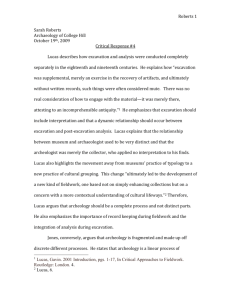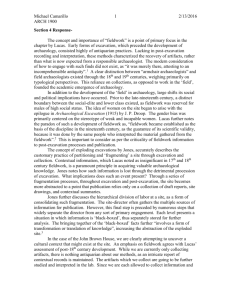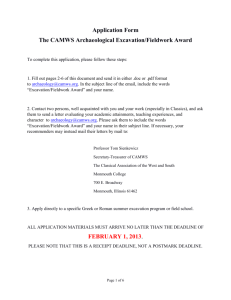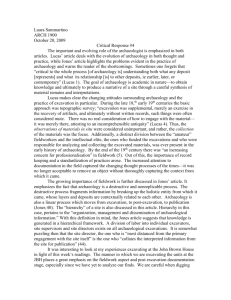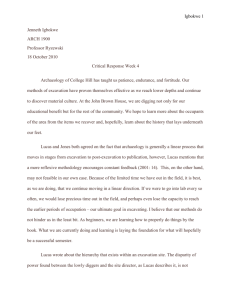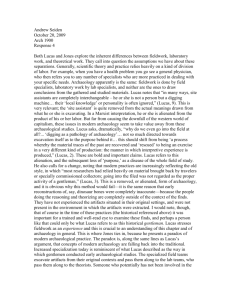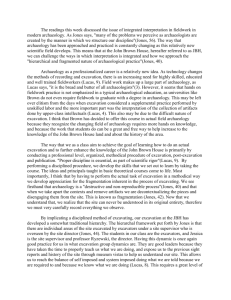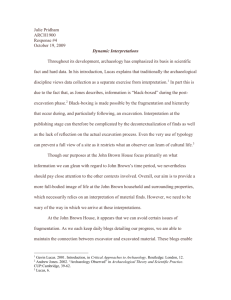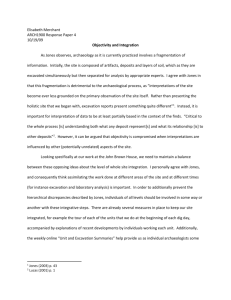Bridget Smith
advertisement
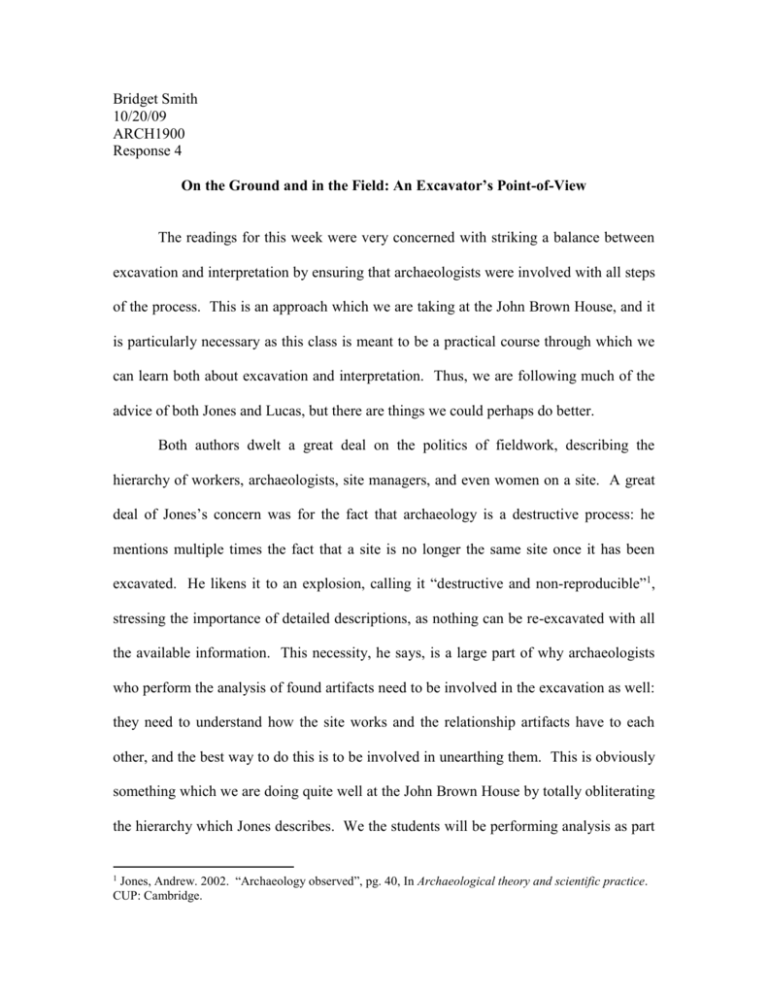
Bridget Smith 10/20/09 ARCH1900 Response 4 On the Ground and in the Field: An Excavator’s Point-of-View The readings for this week were very concerned with striking a balance between excavation and interpretation by ensuring that archaeologists were involved with all steps of the process. This is an approach which we are taking at the John Brown House, and it is particularly necessary as this class is meant to be a practical course through which we can learn both about excavation and interpretation. Thus, we are following much of the advice of both Jones and Lucas, but there are things we could perhaps do better. Both authors dwelt a great deal on the politics of fieldwork, describing the hierarchy of workers, archaeologists, site managers, and even women on a site. A great deal of Jones’s concern was for the fact that archaeology is a destructive process: he mentions multiple times the fact that a site is no longer the same site once it has been excavated. He likens it to an explosion, calling it “destructive and non-reproducible”1, stressing the importance of detailed descriptions, as nothing can be re-excavated with all the available information. This necessity, he says, is a large part of why archaeologists who perform the analysis of found artifacts need to be involved in the excavation as well: they need to understand how the site works and the relationship artifacts have to each other, and the best way to do this is to be involved in unearthing them. This is obviously something which we are doing quite well at the John Brown House by totally obliterating the hierarchy which Jones describes. We the students will be performing analysis as part Jones, Andrew. 2002. “Archaeology observed”, pg. 40, In Archaeological theory and scientific practice. CUP: Cambridge. 1 of our final reports for this class, and we are the primary fieldworkers (with occasional assistance from teachers and TAs). This bodes well for our understanding of our specific units; however, we understand very little of the other units’ finds or composition. This is a common problem, as workers grow attached to and understand their own workspace without knowing anything about the other parts of the site. A proper understanding requires both the overall view of the site and the little details of each unit. We are attempting to remedy our incomplete understanding through weekly summaries on all four units. While an imperfect solution, this does a great deal to improve our comprehension, which is important for, as Jones points out by describing the practices in Britain and Ireland2, understanding the artifacts but not the site as a whole detracts from the information provided by the excavation. Lucas is also concerned with the integration of the site, although he spends more time on the politics of fieldwork than on the actual process. He also describes the evolution of the current state of archaeology, beginning with the old importance of personality in fieldwork and ending with today’s contract fieldworkers, the silent hands of the discipline, arriving at a similar conclusion to Jones’s: that the best understanding comes when the analysts are also excavators. However, he is also highly concerned about the loss of the personal touch. He quotes archaeologist McFadyen3 to emphasize his point that the people who do fieldwork often get lost in the transition from context to text. We are contradicting this by writing weekly blogs, which, in addition to giving an array of individual perspectives, also provide a useful reference point for our timeline of 2 3 Jones 2002, p. 52. Lucas, Gavin. 2001 “Introduction”, p. 13., In Critical Approaches to Fieldwork. Routledge: London. excavation. Like Jones, Lucas writes about the importance of striking a balance and maintaining a relationship between the interpretation of data and the excavation, another thing we are achieving by writing weekly summaries. The biggest problem with our excavation, according to Jones’s and Lucas’s perspectives, is the lack of continuity between seasons. We have last year’s report and the personal accounts of a teacher and a TA, but the rest of us still entered this class with no knowledge of the site or its history. The very fact of this class’s existence means this is not something that can be altered. We instead attempt to satisfy our need for knowledge with our limited resources. With the exception of that irremediable fact, I think both authors would approve of our personal hands-on approach and the way we attempt to get both an overall perspective and the digger’s-eye view. These factors, along with the necessary course hierarchy, allow us to bypass the fieldwork hierarchy that both authors dwell upon as well as the separation of excavation and analysis. We are a special situation at the John Brown House, but these are good practices to establish for any future excavations in which we might take part.
